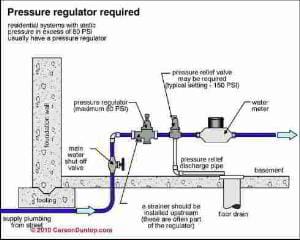 Boost or Improve Poor City Water Pressure
Boost or Improve Poor City Water Pressure
- POST a QUESTION or COMMENT about how to improve weak city or municipal or community water pressure & flow rate
How to improve bad city water pressure:
This article describes how to boost or improve poor city water pressure or flow in a building by adjusting the pressure regulator, replacing small or clogged piping, or installing a water pressure booster pump.
InspectAPedia tolerates no conflicts of interest. We have no relationship with advertisers, products, or services discussed at this website.
- Daniel Friedman, Publisher/Editor/Author - See WHO ARE WE?
How to Boost or Increase Municipal Water Pressure & Flow
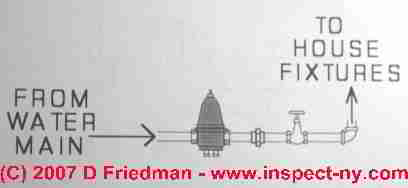 Diagnose Water Pressure Problems Before Starting to "Fix" Them
Diagnose Water Pressure Problems Before Starting to "Fix" Them
Before taking any costly steps to install a booster pump or dig up and replace piping, start at the beginning of this article series:
WATER PRESSURE LOSS DIAGNOSIS & REPAIR
or at MUNICIPAL WATER PRESSURE DIAGNOSIS
to be sure that there is not something to fix in the building water supply piping, water service entry piping, or simply a leak or a valve that is partly shut.
Check and Adjust the Water Pressure Regulator
Before adjusting the water pressure regulator (center of our sketch at left, changing building piping, or considering installing a water pressure booster pump , it is essential to understand what the incoming water pressure is and exactly why the building water pressure is not satisfactory.
[Click to enlarge any image]
Sometimes, even when residential water supply equipment is working normally, building occupants want higher water pressure.
Don't confuse water quantity (how much before we run out), water flow (how many gallons per minute we can get at a faucet) and water pressure (what is the delivery pressure or the maximum pressure that the system can provide). Water pressure is measured most accurately with the water turned off, at a hose faucet or washer hookup, using a pressure gauge.
But in common language, people consider the strength of flow at the faucet as their "water pressure".
Actually what is being observed is a water flow rate, determined by both the pressure from the water source and the diameter of the building piping, including the effects of any obstructions.
Definitions of Water Pressure, Water Flow Rate, & Water Quantity
Water quantity is the total amount of water that is available at a building. For most city water supply systems the water quantity at a home is not limited, though in some areas of limited municipal water quantity, water may be provided by the city water mains only during certain hours of the day, or city water pressure may vary during some times of the day such as during periods of heavy usage.
For people whose buildings are served by a private well system, water quantity is a local and significant question.
See WELL FLOW RATE for details.
Definition of Building Water Pressure - Static Water Pressure
The Carson Dunlop Associates' Home Reference Book points out that people like to have lots of water flow and pressure at faucets.
Water flow (in gallons per minute) is a function of several things, including the size and shape of the faucet opening, and the pressure at the faucet.
The pressure at the faucet is a function of the pressure available from the source, and the pressure lost moving the water through the pipe to the faucet. Typically, city water supplies are at 40 to 70 psi (static pressure).
Psi means Pounds per square inch, and is a common way of measuring water pressure. Pressure loss in the home is due to elevation (we lose pressure when we push water up from one story to the next) and friction as water flows through piping. Larger pipes lose less pressure due to friction.
Static pressure is exerted by the water against the pipe walls with no water flowing. Here’s a simplified (and not 100% accurate) way to look at it. A 100-foot long horizontal pipe connected to a 60 psi supply will have a pressure of 60 psi anywhere along the pipe, with no flow.
As water begins to flow, the pressure drops. This is a result of friction loss along the pipe walls. If gauges were put on the pipe every ten feet, the gauge at the source would still read 60 psi, and (depending on the pipe diameter and the amount of water flowing), the gauge ten feet from the source might read 58 psi; the gauge twenty feet down would read 56 psi, the next gauge 54 psi, et cetera. At the faucet, the pressure might be 40 psi.
As the water flow increases, the pressure drops more at each point along the pipe. The water pressure at the source (city water main) will remain at 60 psi.
The amount of pressure lost due to friction as water flows depends on the pipe diameter and the amount of water flowing. With several faucets open, the flow at each faucet may be weak and there may not be enough pressure for a shower, for example.
Diagnose & Fix Clogged Water Piping or Closed Water Valves
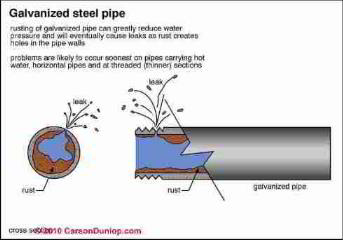 Before changing building water piping diameter or adding a water pressure booster pump (solutions discussed below), check that you don't have a repairable problem with the present water supply piping and or valves in the building.
Before changing building water piping diameter or adding a water pressure booster pump (solutions discussed below), check that you don't have a repairable problem with the present water supply piping and or valves in the building.
Here are some things to check:
- Water supply valve partly closed: a partly-shut water control valve anywhere in the system will reduce the water flow rate (which folks describe as "water pressure" at the fixtures downstream from that point. If you have no idea what types of valves may be in your building
see PLUMBING CONTROLS & VALVES.
Follow the water piping from its entry point at the building through each component or control to look for valves that may be partly closed.
Start at WATER SHUTOFF VALVE LOCATION (municipal water supply)
or at WATER SHUTOFF VALVE, WELL (private well and pump systems). - Pressure regulator control not properly adjusted: we discussed this topic just above - you read that, right?
Details are at WATER PRESSURE REGULATOR ADJUSTMENT. - Clogged water piping: a clog due to debris, a damaged or crimped pipe, crud clogging a single valve or piping elbow, or more serious, mineral-clogged water supply piping will all reduce the flow rate at fixtures in the building.
See WATER PIPE CLOG DIAGNOSIS
If your cold water flow is much better than hot water flow, look for clogged hot water piping or a clogged tankless coil
See CLOGGED PIPES / TANKLESS COIL DE-SCALE
If both hot and cold flow are poor everywhere in the building mineral deposits may have clogged the supply main or cold water piping.
Install Larger Diameter Water Supply Piping
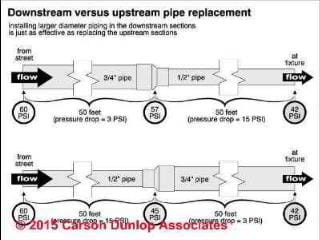
A common "fix" for poor building water "pressure" (really flow) where the piping is blamed, is to install larger diameter water supply piping wherever the piping is readily accessible, such as in a basement or crawl area.
As the sketch at left, courtesy of Carson Dunlop Associates shows, installing larger diameter water supply piping helps regardless of where in the piping sequence it is installed - so you don't have to rip out all of the building water piping to make this water flow rate improvement.
As more plumbing fixtures flow, the pressure and flow drops more at each fixture.
If we replace any ten-foot section of pipe with a larger pipe, the pressure drop across that section will be reduced.
Replacing any section of pipe improves pressure (and flow) throughout the system.
Add a Water Pressure Booster Pump
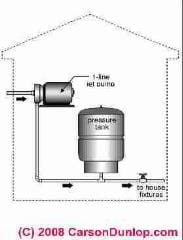
Adding a local municipal water pressure booster pump and a larger water pressure tank in a building with poor municipal water supply pressure will improve local water pressure in the building give a longer water draw-down time between booster pump "on" cycles, which means if your pressure normally ranges between 30 and 50, it will fall from 50 down to 30 more slowly.
It won't boost system pressure beyond the control setting.
If you set the control too high the pump will not reach cutoff temp and will burn up, or if you put in a more powerful pump and boost much over 70 psi you risk plumbing leaks.
Adding a booster pump can improve building water pressure where incoming municipal pressure is low, where the private pump and well system can't get enough pressure or quantity or where the building height impacts water pressure on its upper floors.
More details about figuring out why municipal water pressure is weak are
See WATER PRESSURE BOOSTER PUMP for details.
Our discussion of water pressure and flow diagnosis is divided into water pressure loss symptoms and diagnostic steps
for MUNICIPAL WATER PRESSURE DIAGNOSIS
and separately, WELL WATER PRESSURE DIAGNOSIS - we give procedures for both municipal water supply problems and well water supply problems.
The process of diagnosis and the costs of the repair when municipal water supply, quantity, or flow are poor are explained here.
Separately we also provide
a WATER PRESSURE PROBLEM DIAGNOSIS TABLE
in table format listing nearly every cause of water pressure loss or well pump problem identification, diagnosis, and repair.
Our sketch at page top, courtesy of Carson Dunlop Associates, shows the key components found where municipal water supply enters a building.
...
Continue reading at MUNICIPAL WATER PRESSURE DIAGNOSIS - topic home, or select a topic from the closely-related articles below, or see the complete ARTICLE INDEX.
Or see MUNICIPAL WATER PRESSURE IMPROVEMENT FAQs - questions & answers posted originally on this page.
Or see these
Municipal Water Pressure Articles
- CLOGGED SUPPLY PIPES, HOT WATER
- MUNICIPAL WATER PRESSURE DIAGNOSIS - home
- MUNICIPAL WATER PRESSURE IMPROVEMENTS
- WATER PRESSURE REDUCER / REGULATOR
- WATER PRESSURE BOOSTER PUMP
- WATER PRESSURE IMPROVEMENT
- WATER PRESSURE REDUCER / REGULATOR
Suggested citation for this web page
MUNICIPAL WATER PRESSURE IMPROVEMENTS at InspectApedia.com - online encyclopedia of building & environmental inspection, testing, diagnosis, repair, & problem prevention advice.
Or see this
INDEX to RELATED ARTICLES: ARTICLE INDEX to WATER SUPPLY, PUMPS TANKS WELLS
Or use the SEARCH BOX found below to Ask a Question or Search InspectApedia
Ask a Question or Search InspectApedia
Questions & answers or comments about how to improve weak city or municipal or community water pressure & flow rate.
Try the search box just below, or if you prefer, post a question or comment in the Comments box below and we will respond promptly.
Search the InspectApedia website
Note: appearance of your Comment below may be delayed: if your comment contains an image, photograph, web link, or text that looks to the software as if it might be a web link, your posting will appear after it has been approved by a moderator. Apologies for the delay.
Only one image can be added per comment but you can post as many comments, and therefore images, as you like.
You will not receive a notification when a response to your question has been posted.
Please bookmark this page to make it easy for you to check back for our response.
IF above you see "Comment Form is loading comments..." then COMMENT BOX - countable.ca / bawkbox.com IS NOT WORKING.
In any case you are welcome to send an email directly to us at InspectApedia.com at editor@inspectApedia.com
We'll reply to you directly. Please help us help you by noting, in your email, the URL of the InspectApedia page where you wanted to comment.
Citations & References
In addition to any citations in the article above, a full list is available on request.
- Mark Cramer Inspection Services Mark Cramer, Tampa Florida, Mr. Cramer is a past president of ASHI, the American Society of Home Inspectors and is a Florida home inspector and home inspection educator. Mr. Cramer serves on the ASHI Home Inspection Standards. Contact Mark Cramer at: 727-595-4211 mark@BestTampaInspector.com
- John Cranor [Website: /www.house-whisperer.com ] is an ASHI member and a home inspector (The House Whisperer) is located in Glen Allen, VA 23060. He is also a contributor to InspectApedia.com in several technical areas such as plumbing and appliances (dryer vents). Contact Mr. Cranor at 804-873-8534 or by Email: johncranor@verizon.net
- Thanks to Jeneral Sewer Service - George - 845-297-2285, a New York Hudson Valley drain and sewer cleaning and de-clogging expert for technical details and consulting on drain clog diagnosis and repair, including proper use of the Kinetic Water Ram for drain clearing - 3/14/2009
- Thanks to our reader, Carole Cimitile, 2/17/2009, for reminding us that small problems like faucet o-rings, clogged faucet strainers and similar local plumbing fixture defects can have a big impact on hot water flow, cold water flow, or both hot and cold water flow and pressure problems.
- Thanks to reader EK Woodard, Boise State University, Boise ID, for assistance in diagnosing poor water pressure following an electrical power loss. 3/14/2010
- Thanks to reader Regina Craig for discussing water pressure loss diagnosed as due to water filter clogging 6/25/2009
- Thanks to reader Carole Cimitile, for pointing out that bad water pressure and flow can occur at multiple fixtures at once when multiple fixture repairs are needed - it's not necessarily a clogged pipe or other water system problem. Feb 2009.
- Our recommended books about building & mechanical systems design, inspection, problem diagnosis, and repair, and about indoor environment and IAQ testing, diagnosis, and cleanup are at the InspectAPedia Bookstore. Also see our Book Reviews - InspectAPedia.
- In addition to citations & references found in this article, see the research citations given at the end of the related articles found at our suggested
CONTINUE READING or RECOMMENDED ARTICLES.
- In addition to citations & references found in this article, see the research citations given at the end of the related articles found at our suggested
CONTINUE READING or RECOMMENDED ARTICLES.
- Carson, Dunlop & Associates Ltd., 120 Carlton Street Suite 407, Toronto ON M5A 4K2. Tel: (416) 964-9415 1-800-268-7070 Email: info@carsondunlop.com. Alan Carson is a past president of ASHI, the American Society of Home Inspectors.
Thanks to Alan Carson and Bob Dunlop, for permission for InspectAPedia to use text excerpts from The HOME REFERENCE BOOK - the Encyclopedia of Homes and to use illustrations from The ILLUSTRATED HOME .
Carson Dunlop Associates provides extensive home inspection education and report writing material. In gratitude we provide links to tsome Carson Dunlop Associates products and services.

